NVIDIA’s GeForce GTX 460: The $200 King
by Ryan Smith on July 11, 2010 11:54 PM EST- Posted in
- GPUs
- GeForce GTX 400
- GeForce GTX 460
- NVIDIA
Overclocking
Last but not least on our tour of the GeForce GTX 460 is a look at the overclocking abilities of the card. As we discussed earlier, NVIDIA is heavily promoting the overclockability of the card to the press, proclaiming that they are regularly able to get most cards up to 800MHz. We’re in a unique situation today to put that to the test, as along with our 2 reference cards, we have an additional 4 vendor cards from our GTX 460 roundup to tinker with. With 6 cards on hand we have a non-definitive but still very useful sample set to work with to verify just how overclockable these cards are, and what kind of a power penalty this entails.
For the purposes of this section we are focusing on the overclockability of the core, but not the memory. NVIDIA’s weaker GDDR5 memory controller coupled with the tendency for memory overclocking to reduce performance through the need to use error detection and retransmission makes memory overclocking much more difficult and often a bust entirely.
As not all of our cards are exactly alike, we’ll quickly run down the differences between the various cards
- 1x NVIDIA GTX 460 768MB Reference
- 1x NVIDIA GTX 460 1GB Reference
- 2x EVGA GTX 460 768MB SuperClocked: Reference PCB and cooler, factory overclocked
- 1x Zotac GTX 460 1GB: Reference-derived PCB, custom blower-style cooler
-
1x Asus ENGTX460 768MB TOP: Custom PCB, custom cooler, factory overclocked, voltage tweak
| Stock Clock | Max Overclock | Stock Voltage | Overclocked Voltage | |
| GTX 460 768MB Reference | 675MHz | 840MHz | 0.987v | N/A |
| GTX 460 1GB Reference | 675MHz | 825MHz | 1.025v | N/A |
| EVGA GTX 460 768MB SuperClocked #1 | 763MHz | 850MHz | 1.000v | N/A |
| EVGA GTX 460 768MB SuperClocked #2 | 763MHz | 840MHz | 0.975v | N/A |
| Zotac GTX 460 1GB | 675MHz | 835MHz | 1.000v | N/A |
| Asus ENGTX460 768MB TOP | 700MHz | 930MHz | 0.975v | 1.062v |
| GTX 460 1GB SLI | 675MHz | 800MHz | N/A | N/A |
| EVGA GTX 460 768MB SuperClocked SLI | 763MHz | 840MHz | N/A | N/A |
Among our 5 cards without voltage tweaking capabilities, all of the cards are closely clustered together in terms of the final stable overclock, with only a 25MHz difference between the top and bottom cards. The 1GB cards ended up with slightly lower overclocks than the 768MB cards, which is likely a product of the 1GB cards containing further enable ROPs and L2 cache than the 768MB cards. Meanwhile the best overclock on a card we got without a voltage tweak was one of our EVGA cards, which was able to go to 850MHz. On average we were able to attain a 24% overclock over the GTX 460 reference clock of 675MHz, and in the case of the EVGA cards a 10% overclock over their factory speed of 763MHz.
The lone standout in the group is the Asus card, which has voltage tweaking capabilities that allow us to increase the core voltage beyond the GPU’s VID. Asus’s SmartDoctor software allows for the card to be overvolted to 1.087v in 0.0125v increments, however in testing we found that anything over 1.062v would ultimately cause the card to fall back to 405MHz, which we believe to be the card’s VRM protection kicking in after the VRMs overheated. At 1.062v we were able to get the card to up 930MHz, a 33% overclock from the factory overclocked speed of 700MHz, and 38% faster than the GTX 460 reference clock of 675MHz.
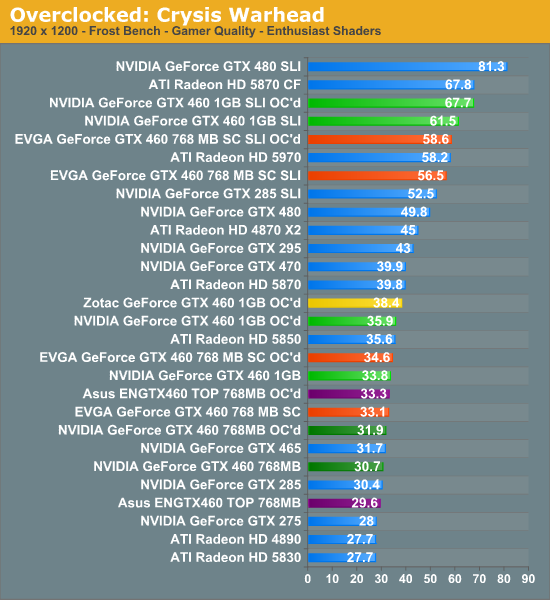

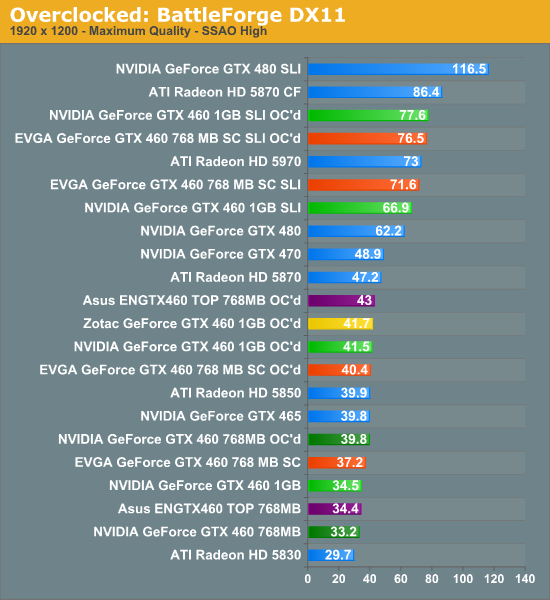
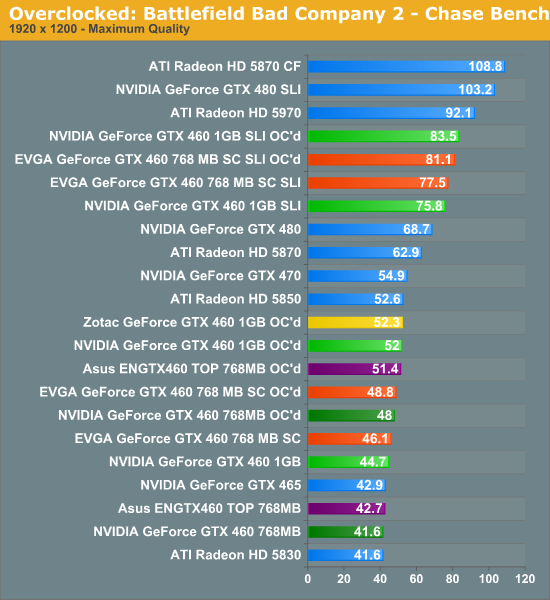
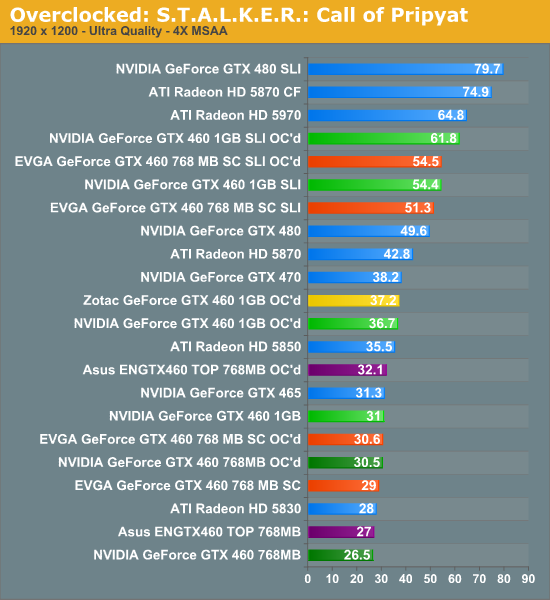
Overall the impact of overclocking is heavily game dependent. Core overclocking favors games that are ROP/shader limited and has little effectiveness on games that are limited by the total available RAM or by memory bandwidth. For this reason out of our subset of games core overclocking was most effective on Battleforge and Bad Company 2, while only moderately effective on Crysis and STALKER. On Crysis and STALKER overclocking was at best only marginally more useful than having a 1GB card. And even with its greater core overclock, the Asus ENGTX260 is not immune to this effect once the 1GB cards are overclocked – it still falls behind an overclocked 1GB card ¾ of the time.
Currently the sweet spot would look to be a 1GB card with a lesser overclock. The additional RAM/L2/ROPs more than makes up for the higher overclocks the 768MB cards can attain in most situations.
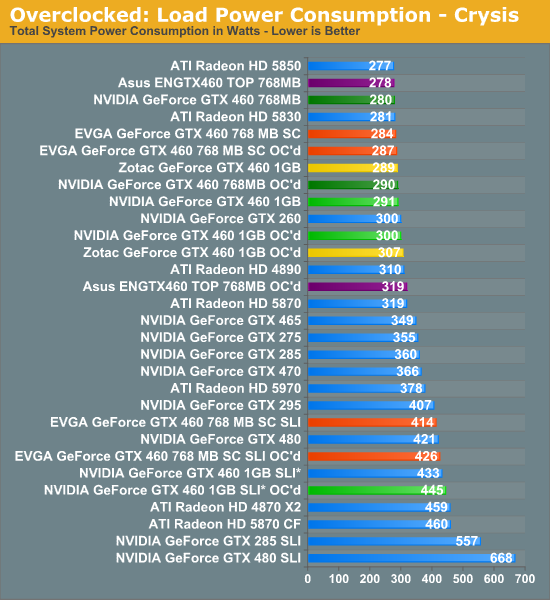
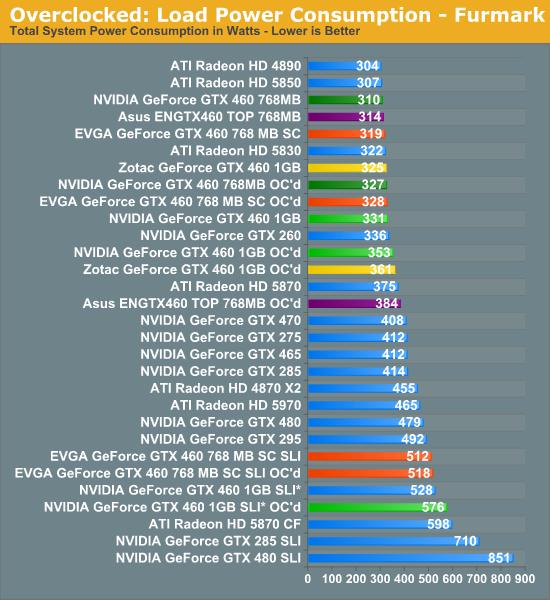
For the cards without voltage tweaking capabilities, the power consumption penalty for overclocking is very minor due to the fact that power consumption increases with voltage much faster than it does with frequency. For the stock-clocked cards this is a 15W-25W penalty, while the factory overclocked cards are even lower (thanks to binning) at just 9W. Meanwhile as expected the Asus card with its voltage tweaking capabilities ends up witnessing a larger jump in power consumption in return for its greater overclock capabilities: 70W.
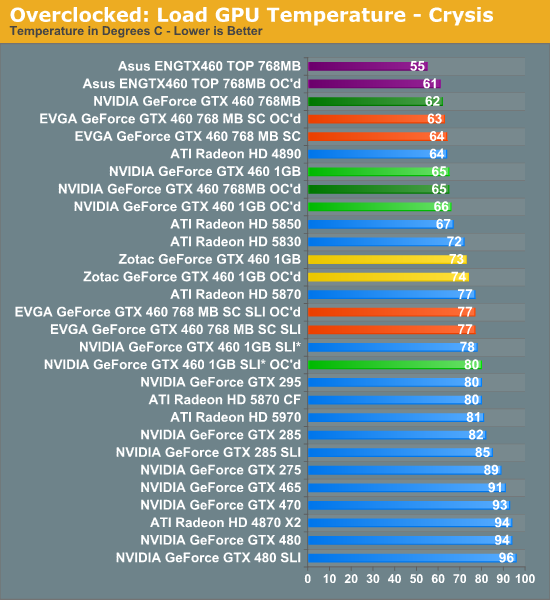
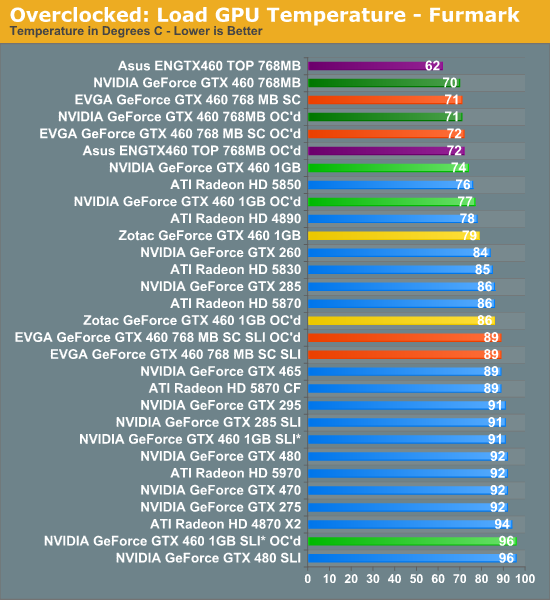
With only a minor increase in power consumption and the use of very efficient coolers, the GTX 460 only experiences a minor rise in temperature when overclocking without voltage modification. All of our cards with the exception of the Zotac under Furmark only rise in temperature by a few degrees, leaving temperatures well in the safe range for these cards. Even the Asus card with voltage modification stays fairly cool thanks to its more aggressive fan, rising by up to 10C under Furmark but still only becoming as warm as our stock-cooled cards in the first place.
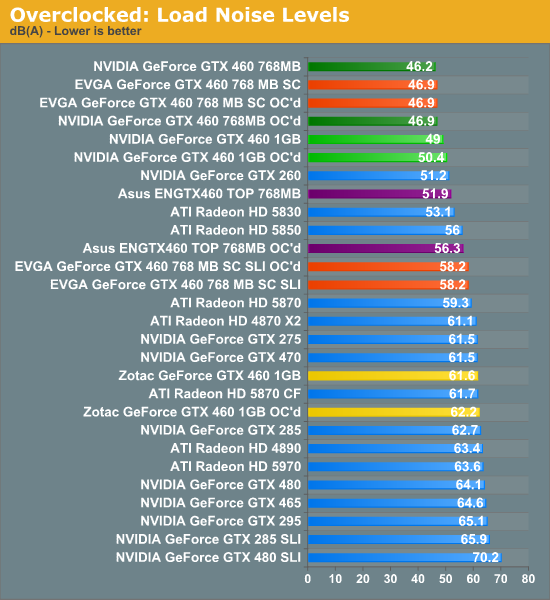
Last but not least we have the noise factor. Thanks to the very low increase in power consumption these cards experience when overclocking, the coolers on these cards have to do very little to handle the extra heat. For the cards without voltage modding, the amount of noise generated increased by less than 1.5dB, and in the case of our EVGA cards didn’t increase at all. This results in our GTX 460 cards remaining as some of the quietest mid and high-end cards we’ve ever benchmarked, even with a 24% overclock.
The Asus card is of course the exception to the rule here, once again due to a combination of the more aggressive cooler and voltage modification. Here the amount of noise generated shoots up by 4.4dB when overclocked, which is a fair trade for the overclock but is definitely going to be more noticeable than the rest of the cards in our collection.
With all of this taken in to consideration, there’s little we can do to argue with NVIDIA’s claims about the GTX 460’s overclocking capabilities. One thing we need to make clear before going any further though is this: overclocking is not guaranteed. In our briefings with NVIDIA, they have told us that they know not every GTX 460 can hit 800MHz+, which in turn is part of the reason why the stock clock is only 675MHz. We believe a majority of cards will be strong overclockers, but this cannot be applied to all cards. Buying a GTX 460 is still going to rely on the luck of the draw, only the odds are very good at the moment. So if you absolutely must have an overclocked card, then a factory overclocked card is still the way to go.
At this point if you do receive a strong card it makes little sense not to overclock thanks to the very small increase in power consumption (and as a result, temperatures and noise) that overclocking causes. This is as close to as free of an overclock as there can be for a video card, so run with it and enjoy performance approaching a Radeon HD 5850.
Finally, if you are going to overclock, what kind of a card should you be shooting for? As it turns out the reference cooler does a very good job of hitting a balance between cooling needs and noise, while Zotec’s cooler does worse and Asus’s cooler does better at a cost of additional noise. We will add that we believe that overclocked 1GB cards are a better way to go just like we believe that 1GB cards are the way to go when at stock clocks, but ultimately this becomes a matter of affordability.










93 Comments
View All Comments
dumpsterj - Tuesday, July 13, 2010 - link
the gtx 465 was a joke , especially at the price. however , this 460 looks like a great card at a great price. If this is a sign of things to come from nvidia us guys running ati right now might have to take notice.Algorithm - Tuesday, July 13, 2010 - link
I see a lot of ATI fanboys on here. Read other reviews, a GTX 460 *1GB* OCed past 800 beats a HD5850 and gets in HD5870 territory. In DirectX 11, this 460 really shines over.Don't forget, the reviews are based on Nvidia drivers that are *1 day old* now. Expect the GTX 460 framerates to increase even more once the drivers mature.
I was almost ready to pull the trigger on a HD5850, but glad I held back (read: I really don't care for either Nvidia or ATI). I really see the GTX 460 being a standard that game software developers will use in the future. Features like CUDA, Fermi and PhysX will play a more significant role in newer games. I just want a card that gives me most for my money.
FuzzDad - Wednesday, July 14, 2010 - link
Pretty nice price coupled w/performance should make this an SLI powerhouse if you can't afford SLI on the 470/480. My 3x GTX 275 setup is solid...but I'm leaning towards 2X 460 now.Xpl1c1t - Wednesday, July 14, 2010 - link
How much better it would have been to see the 384SP version on launch day... seriously wtf is wrong with NV&TSMC's circuit design/fab process that makes manufacture of FULL parts so much more difficult than it is for ATI&TSMC? 5770, 4770, and 4750 were all full die parts produced with good yields TSMC. Genuinely, though some may be alright with it, there is no desire for dead silicon.aussiestilgar - Tuesday, July 20, 2010 - link
Yes. Ryan, is there anything on the grapevine that whispers Nvidia releasing the GF104 at full strength? Inklings of when? Cheers.Sunburn74 - Wednesday, July 14, 2010 - link
Pretty impressive gtx 460 crossfire results, trading blows with crossfire setups double its value. Overall a nice card, but shame it wasn't released 6 months ago when a lot of us just got tired of waiting. I probably would have bought it over the 5850 had this card been released in time. Oh well... better luck next year for Nvidia to take my money.mapesdhs - Monday, July 19, 2010 - link
(I think you mean GTX 460 SLI. ;)
...
I hate to be a comment repeater, but can 5850 CF results please be
included? The tables are distinctly incomplete without this since the
1GB 460 clearly competes directly against the 5850; the most common
discussion I see on forums is how 1GB 460 SLI compares to 5850 CF. On
price alone, 1GB 460 SLI is definitely better, so no wonder there are
games-bundling deals such as the following now appearing to sweeten
5850 sales:
http://www.aria.co.uk/SuperSpecials/newsletter?pro...
Ian.
kajzatom - Thursday, August 19, 2010 - link
I want ask how did You make test Badaboom on GTX 460? According to Elemental Technologies inc. currently Badaboom doesn't support GF100,GF104 graphic card. Apps. crashed if try open any video file.fr500 - Tuesday, September 14, 2010 - link
You know a thing I would love.To be able to select the cards you are interested in with checkboxes in the reviews so you can compare the cards easily. I know there is the GPU bench but I can't seem to compare more than 2 gpus at a time.
WiseCow - Wednesday, November 17, 2010 - link
Fresh levels load very jerky, like steps fwd, as the game begins and causes the first few seconds to halt, halt, halt, until everything loads. My 8800GTX did not do this, everything woud run smooter as the textures loaded. I'm also experiencing long waits for the screen to turn on after time outs or sleep. Black Ops was unplayable and other games that ran smoothly on the 8800 now are jerky. Sniff...